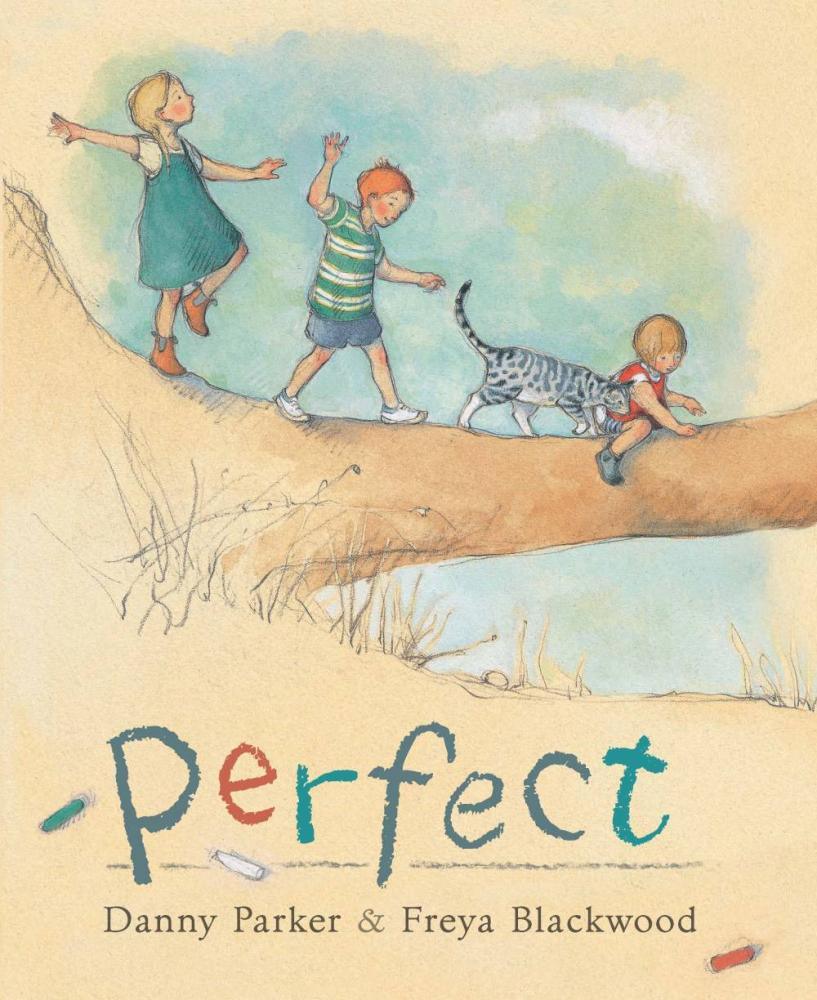Danny Parker (text), Freya Blackwood (illus.), Perfect, Hardie Grant, 8 Oct 2015, 32pp., $20.00 (pbk), ISBN: 9781760125554
This picture book is a gentle mediation on the nature of happiness. It follows three children aged about 2, 6 and 8 on their day as they play together in their house and the surrounding countryside, ending with the affirmation that their day has been “perfect.”
Parker’s words read like poetry; they offer a suggestion of activity, but not a lot of detail. For instance, he writes “Some sunshine and something to nibble. Some space with enough room to scribble.” The sparse words make the book a slow and thoughtful read. The reader is given space to go off on their own imaginative tangents: ‘I have “some shoes and some places to walk to.” Where should I walk to?’ The slow pace also allows the reader to linger over the illustrations and catch the details of everyday life depicted in the pages, such as the lost building blocks and toy cars scattered all over the living room floor. The words do rhyme, which normally I dislike in picture books, but as the pace is slow and there is rarely more than one sentence on each page, the rhyme is unobtrusive.
Freya Blackwood’s illustrations in this book are characteristically lovely. They are created using pencil and acrylic paint, and have a sort of sketchy unfinished quality which is very pleasant. The illustrations are mainly constructed of curved lines and pastel tones, enhancing the relaxed pastoral quality of the picturebook. I particularly enjoy how kid-ish the children look. Although they’re dressed in somewhat old-fashioned clothing, they are still recognisably actual children like the kind we have in our homes, breaking bowls, super-gluing things to their hands, and letting the cat steal toast. I particularly like their expressive bare feet and reddish knees.
The pages are carefully designed and create a sense of space. For instance, the double spread for “Some shade and then someone to talk to” has a mostly blank left page, with only half a tree spreading out onto it, while the right page has the three children nose to nose with two cows in the bottom half of the page. The slightly elevated perspective (not quite bird’s eye) reduces the size discrepancy between the children and the cows -they are obviously meeting as equals – and the cows’ bodies form a triangle which leads the eye to the children. The top line of this triangle is echoed by a branch at the top of the right hand page, on which the family cat is perched, watching the scene in much the same way the reader is. This thoughtful picture design is very pleasurable to read, and sets this book apart from the work of less experienced illustrators.
My main criticism of the book is that most children reading it will never have experienced the sort of free range day that the protagonists enjoy. Contemporary parents generally don’t allow their young children to take the toddler out for the day and roam the countryside. Although I can see why Blackwood might think children would enjoy and benefit from this freedom, this choice makes a barrier between most child readers and the text. I would be interested to see a sub/urban illustration of the same words which draws out the pleasures of a day more likely to be experienced by contemporary children (having space to scribble on the back of office paper, wearing shoes and walking to the park with a parent, enjoying shade and talking with friends they run into on the way home, etc.).
At first glance this book looks like it’s more for adults than children, but on repeated readings I can see its attraction for children to find some quiet time in its pages. The gentle repetitive words and engaging illustrations encourage slow reading, giving a child time to relax and reflect on their own day and their own pleasures. I highly recommend Perfect for young readers to slow down, lose themselves in the illustrations and explore the nature of happiness.
Reviewed by Lian Beveridge

